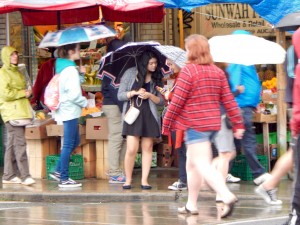Inspiring the Bioregional Imagination

Originally appears in the Fall 2015 issue
Every day teachers are challenged to design creative learning activities connecting kids with the places they live. We are finding interesting ways across the curriculum to deepen students’ relationships with their larger living communities. In suburban and rural schools, this may mean exploring the biotic community through outdoor learning, wilderness and field trips. In larger urban areas, student and teacher interest may lean toward schoolyard clean ups, gardens, establishing safe play areas and beautification projects. No matter the activity or the place, rural or urban, wild or densely populated, each community belongs to a specific bioregion.
Literally, the word bioregion means life-place. A bioregion is definable by natural boundaries with ecological and climatic characteristics that support distinctive human, plant and animal communities. Bioregional thinking and imagining provides another way to understand our reliance on the places we live and to appreciate the plant and animal ecosystems, the watersheds, the landforms (mountains, prairie, coastal zones) and the human cultures connected to these regions.
Bioregionalism, a term coined in the 1970s, offers a more human scale to ecological issues that impact communities. Often large environmental crises can overwhelm us, and teachers understand that children, particularly, can be affected negatively by dire predictions of global crises. Bioregionalists prefer a more positive approach by imagining our local places as communities where we live sustainably by learning to “re-inhabit” our places and by getting to know our places more deeply.
My interest is in how literature; story, poetry, visual, and digital representations of a bioregion can broaden and deepen the imagination and our understanding of what it truly means to live within a place. When we become attuned to our places, our neighborhoods, the issues, history, biology, literature, and art we point away from ourselves to know the world as filled with a variety of locally interdependent places. In this sense bioregionalism leads out into the larger world for a deeper understanding of the place of the local community within the world.
To view the photo-rich magazine version, click here.
If you are not already a subscriber, please subscribe to read the full article
Patrick Howard is a former middle and high school teacher. He is currently Associate Professor of Education at Cape Breton University in Sydney, Nova Scotia.
Notes
[i] Chawla, Louise. 1998. Significant life experiences revisited: A review of research on sources of environmental sensitivity. The Journal of Environmental Education 29 (3):11-21
[ii] Tuan, Y. (1976). Literature, experience and environmental knowing. In G. Moore and R. Golledge (Eds.), Environmental knowing, theories, research and methods. (pp. 260-272). Stroudsbourg, Penn.: Dowden, Hutchinson and Ross.
[iii] Holmes, Nancy. 2009. Open Wide a Wilderness: Canadian Nature Poems. Sir Wilfred Laurier Press.
[iv] Anand, Madhur and Adam Dickinson. 2009. Regreen: New Canadian Ecological Poetry. Your Scrivener Press.
[v] Tredinnick, Mark. 2004. A Place on Earth: An Anthology of Nature Writing from Australia and North America. University of Nebraska Press.
[vi] Goddard, Sally. 1995. Gaddy’s Story: The First Weeks in the Life of an Atlantic Cod. Breakwater Books Ltd.
[vii] Pittman, Al. 1976. Down by Jim Longs Stage: Rhymes for children and young fish. Breakwater Books Ltd.
[viii] St. Antoine, Sarah. 2004. Stories From Where We Live (series of 4 books). Milkweed Press.
[ix] Pare´, Arleen. 2014. The Lake of Two Mountains. Brick Books.
[x] Dig Your Neighbourhood. http://blogs.ubc.ca/theecoartincubator/.
[xi] Dronyk, Dymphyny, and Kris Demeanor. 2014. The Calgary Project: A City Map in Verse and Visual. Frontenac House and House of Blue Skies Press.
[xii] Toronto Poetry Map. http://www.torontopoetry.ca
[xiii] Eigenbrod, Renate, Georgina Kakegamic and Josias Fiddler. 2003. Aboriginal Literature in Canada: A Teacher Resource. http://www.curriculum.org/storage/30/1278480166aboriginal.pdf –
[xiv] Thurston, Harry. 2005. The Sea‘s Voice: An Anthology of Atlantic Canadian Nature Writing. Nimbus Books.
Leave a Reply
You must be logged in to post a comment.





